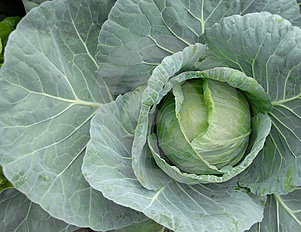Cabbage and Fermented Foods- Essential parts of the GAPS diet
 Monday, February 25, 2013 at 6:55PM
Monday, February 25, 2013 at 6:55PM  brookek tagged
brookek tagged  GAPS Diet Recipe,
GAPS Diet Recipe,  fermenting your own probiotics,
fermenting your own probiotics,  raw sauerkraut recipe
raw sauerkraut recipe  Email Article
Email Article  Print Article in
Print Article in  Health,
Health,  Recipe
Recipe 
BY GUEST BLOGGER, BROOKE KAUFMAN, CNC
Probiotic foods are a key part of the GAPS diet. They can be dairy-based (homemade yoghurt, whey, kefir or sour cream) or vegetable-based, like sauerkraut or other fermented vegetables. For those who can tolerate dairy, these homemade raw dairy products contain lactic acid and other substances that soothe and strengthen the gut lining.
For those who cannot tolerate dairy, fermented vegetable juices not only provide beneficial bacteria, but also help to restore stomach acid levels to normal. Cabbage is particularly good to use as a fermented vegetable.
Digestive Tract Support
Long-established in health research is the role of cabbage juice in helping heal stomach ulcers (called peptic ulcers), but more recent studies on cabbage have looked at the overall health benefits of this food for the stomach and digestive tract as a whole. Present-day studies make it clear that cabbage contains a variety of nutrients of potential benefit to our stomach and intestinal linings. These nutrients include glucosinolates (and the anti-inflammatory isothiocyanates or ITCs made from them) which regulate bacterial populations of Helicobacter pylori in the stomach. Cabbage juice also contains antioxidant polyphenols, and the amino acid-like substance called glutamine, which helps to soothe the inflamed tissues.
History
Cabbage has a long history of use both as a food and a medicine. It was developed from wild cabbage, a vegetable that was closer in appearance to collards and kale since it was composed of leaves that did not form a head. It is thought that wild cabbage was brought to Europe around 600 B.C. by groups of Celtic wanderers. It was grown in Ancient Greek and Roman civilizations that held it in high regard as a general panacea capable of treating a host of health conditions.
While it's unclear when and where the headed cabbage that we know today was developed, cultivation of cabbage spread across northern Europe into Germany, Poland and Russia, where it became a very popular vegetable in local food cultures. The Italians are credited with developing the Savoy cabbage. Russia, Poland, China and Japan are a few of the leading producers of cabbage today.
Sauerkraut, a dish made from fermented cabbage, has a colorful legacy. Dutch sailors consumed it during extended exploration voyages to prevent scurvy. Early German settlers introduced cabbage and the traditional sauerkraut recipes were introduced into the United States. As a result of this affiliation, German soldiers, and people of German descent were often referred to as "krauts."
Fermented Cabbage with Beets, Carrots and Ginger
INGREDIENTS
1/3 of a medium-sized red or green cabbage, cut into 2-inch wedges
3 large carrots, whole
2 medium red beets, cut into 2-inch pieces
2 to 3-inch piece of ginger, grated or minced
1/2 of a lemon, juiced
1 to 3 teaspoons sea salt, to taste
1/4 teaspoon red chili flakes
1 quart jar
INSTRUCTIONS
1. With the grating blade inserted into food processor, grate cabbage, carrots and beets. You can also grate these vegetables by hand or chop. Combine in a large bowl with ginger.
2. Sprinkle salt, chili flakes and lemon juice. Mix and massage well with your hands to release some of the liquid. The mixture should be quite wet and you should quickly see a good amount of liquid pool in the bottom of the bowl. Taste and add salt, if necessary.
3. Transfer a couple handfuls of the mixture into the jar and push down with your fist to remove all air pockets. Keep pressing handfuls of the mixture into the jar until it is about 3 inches from the top. Wipe the inside of the jar’s neck with a paper towel.
4. Take a smaller bottle that will fit into the mouth of the jar. Fill it with water and cap it. Press the smaller jar into larger jar.
When pressed down, the vegetables should be completely submerged under the liquid. Then, take a cloth towel and drape it over the jar and secure with a rubber band. The napkin does two things - keeps out fruit flies and other unwanted critters and keeps out unwanted light.
5. Set the jar in a saucer, small bowl or pan to catch any juices that may overflow. Keep in a dark place such as a cupboard at room temperature. The time it takes to ferment will depend on what room temperature is. It will slowly ferment in cool temperatures and quickly ferment in warm. Taste it after 2-3 days if it’s between 60º-70º F, or up to a week if colder. Taste sooner if over 70ºF.
6. When you like the taste, transfer the jar to a refrigerator to slow down the fermenting. This will keep in the refrigerator for up to 2-3 months.
Makes about a quart.
NOTES:
Alternatively, you could ferment this with the lid on. First, wipe the inside of the neck with a clean paper towel. Take a leaf or two of the cabbage and roll it up. Cut the rolls to fit into the remaining space in jar. Loosely screw on a lid.
If you see a grey layer on top, scrape the top layer off. The rest is still good to eat. Always trust your nose and your eyes. If it smells off or looks slimy, toss it. Good ferments should have a fresh and acidic aroma.
Grating the veggies breaks down the cell walls a bit more than simply chopping, so they will release liquid more quickly. You won’t need to massage the vegetables very much. The smaller size allows you to pack a bit more vegetable tightly into the jar and also gives the ferment a more delicate chew.
To learn more about sauerkraut: http://www.nourishingtreasures.com/index.php/2012/05/15/the-science-behind-sauerkraut-fermentation/
About the Author
 Brooke Kaufman is a Certified Holistic Nutrition Consultant who creates customized meal plans for her clients with multiple food allergies and intolerances, and for those who are on the GAPS diet. She enjoys helping people eat nourishing food that is easy to prepare and tastes delicious. She believes that having food allergies and intolerances can be a positive challenge that inspires creativity, and brings a higher level of awareness when it comes to what you put in your body. Brooke believes that when we deeply nourish ourselves inside and out, we can attain optimal health…which includes healing our damaged and inflamed digestive systems.
Brooke Kaufman is a Certified Holistic Nutrition Consultant who creates customized meal plans for her clients with multiple food allergies and intolerances, and for those who are on the GAPS diet. She enjoys helping people eat nourishing food that is easy to prepare and tastes delicious. She believes that having food allergies and intolerances can be a positive challenge that inspires creativity, and brings a higher level of awareness when it comes to what you put in your body. Brooke believes that when we deeply nourish ourselves inside and out, we can attain optimal health…which includes healing our damaged and inflamed digestive systems.
Brooke received her nutrition education at Bauman College, and has learned through her own personal experience with food intolerances, she also works as a cleanse coach for Cleanse Organic, a 28-day, guided whole food based cleansing program.
Find her at: Balance Within Nutrition


Reader Comments (2)
Thank you :)
So excited you are trying the GAPS diet. Nutritionist Brooke Kaufman and I will be starting a GAPS INTRO online challenge after Memorial Day which will offer 3 weeks of support including webinars, GREAT guest speaker, and email q &a. If you are interested in joining us (we will be doing the diet along with everyone), stay tuned for more details. We are almost finished planning.
As for the food processor, I love Kitchen Aid (its a nice size, too) and Brooke loves her Black and Decker. For GAPs, you will probably get more use out of a pressure cooker (Brooke prefers, and recommends Fagor brand) or a slow cooker (what I prefer). Slow cooker brands aren't as big of a deal - I use Crockpot and a 6 quart will fit a whole chicken for the broths. Choose a ceramic or stoneware regardless of the brand.
Does this help? and drop a note and let me know how your GAPS diet is going!
beth